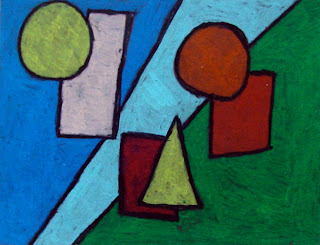 This was my third after-school paper mache project this year, and I must say that I learned a LOT from doing this with 20 students, mostly grades kinder and 1st. These pigs took 5 class sessions to complete.
This was my third after-school paper mache project this year, and I must say that I learned a LOT from doing this with 20 students, mostly grades kinder and 1st. These pigs took 5 class sessions to complete.1. The first class was just about having each student cover a 12" balloon with a couple of layers of newspaper and paper mache. My favorite recipe is posted
here. One thing I learned was to tie the balloon really tight, as it was best if it stayed inflated through the 2nd class. Students that had only one layer of newspaper in the first class (and popped balloons) had shapes that collapsed in the second.
2. The students covered their balloons with a second layer of newspaper. In hindsight, I would have asked them to place their strips in a different direction so that they could see their progress more easily.
3. To smooth out the body and cover up the darkness of the newspaper, the students covered their ballon with a layer of mache covered paper towel strips.
4. To prep the pigs for the students, I used small white styrofoam cups (the 2" tall type from Smart & Final) and glued them with Tacky glue to the bottom for feet, and over the knot of the balloon for the snout. A curved section of the cups was also cut and glued for the ears. This was done a day before class to make sure the glue would dry. During class, time the students made one more paper towel mache covering, making sure they covered the ears, nose and feet of their pig.
5. At last, paint day! I limited the students to one acrylic color (pink) for budget reasons, but let them add any decorations they wished. After the paint dried, I cut the coin slots with a razor knife and sprayed the entire pig with a shiny varnish.
 I’ve collected a variety of decorative letters from clipartETC.com and arranged them on a jpeg file that you can print and hand color for a quick but fancy Happy New Year sign.
I’ve collected a variety of decorative letters from clipartETC.com and arranged them on a jpeg file that you can print and hand color for a quick but fancy Happy New Year sign.

 9:59 PM
9:59 PM
 keprok
keprok























